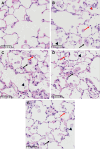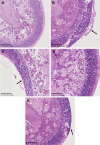Toxicological inhalation studies in rats to substantiate grouping of zinc oxide nanoforms
- PMID: 38760761
- PMCID: PMC11100124
- DOI: 10.1186/s12989-024-00572-y
Toxicological inhalation studies in rats to substantiate grouping of zinc oxide nanoforms
Abstract
Background: Significant variations exist in the forms of ZnO, making it impossible to test all forms in in vivo inhalation studies. Hence, grouping and read-across is a common approach under REACH to evaluate the toxicological profile of familiar substances. The objective of this paper is to investigate the potential role of dissolution, size, or coating in grouping ZnO (nano)forms for the purpose of hazard assessment. We performed a 90-day inhalation study (OECD test guideline no. (TG) 413) in rats combined with a reproduction/developmental (neuro)toxicity screening test (TG 421/424/426) with coated and uncoated ZnO nanoforms in comparison with microscale ZnO particles and soluble zinc sulfate. In addition, genotoxicity in the nasal cavity, lungs, liver, and bone marrow was examined via comet assay (TG 489) after 14-day inhalation exposure.
Results: ZnO nanoparticles caused local toxicity in the respiratory tract. Systemic effects that were not related to the local irritation were not observed. There was no indication of impaired fertility, developmental toxicity, or developmental neurotoxicity. No indication for genotoxicity of any of the test substances was observed. Local effects were similar across the different ZnO test substances and were reversible after the end of the exposure.
Conclusion: With exception of local toxicity, this study could not confirm the occasional findings in some of the previous studies regarding the above-mentioned toxicological endpoints. The two representative ZnO nanoforms and the microscale particles showed similar local effects. The ZnO nanoforms most likely exhibit their effects by zinc ions as no particles could be detected after the end of the exposure, and exposure to rapidly soluble zinc sulfate had similar effects. Obviously, material differences between the ZnO particles do not substantially alter their toxicokinetics and toxicodynamics. The grouping of ZnO nanoforms into a set of similar nanoforms is justified by these observations.
Keywords: Developmental toxicity; Genotoxicity; Inhalation toxicity; Metal oxide; Nanoparticles; Reproductive toxicity; Zinc oxide.
© 2024. The Author(s).
Conflict of interest statement
DFW, HM, KW, LMH, MD, NH, RL, SG, StS, SvS, ST, VS, WW are employees of BASF SE, a chemical company producing and marketing nanomaterials. TT is an employee of the BASF group company BASF Services Europe GmbH supporting BASF SE. NL and CS are employees of the International Zinc Association, MV and ND are employees of Helix3.
Figures








Similar articles
-
NMR-based metabolomics to determine acute inhalation effects of nano- and fine-sized ZnO particles in the rat lung.Nanotoxicology. 2016 Sep;10(7):924-34. doi: 10.3109/17435390.2016.1144825. Epub 2016 Mar 8. Nanotoxicology. 2016. PMID: 27245357
-
Health effects after inhalation of micro- and nano-sized zinc oxide particles in human volunteers.Arch Toxicol. 2021 Jan;95(1):53-65. doi: 10.1007/s00204-020-02923-y. Epub 2020 Oct 1. Arch Toxicol. 2021. PMID: 33001223 Free PMC article.
-
Particle Size and Biological Fate of ZnO Do Not Cause Acute Toxicity, but Affect Toxicokinetics and Gene Expression Profiles in the Rat Livers after Oral Administration.Int J Mol Sci. 2021 Feb 8;22(4):1698. doi: 10.3390/ijms22041698. Int J Mol Sci. 2021. PMID: 33567653 Free PMC article.
-
Toxicokinetics of Nanoparticles Deposited in Lungs Using Occupational Exposure Scenarios.Front Public Health. 2022 Jun 21;10:909247. doi: 10.3389/fpubh.2022.909247. eCollection 2022. Front Public Health. 2022. PMID: 35801236 Free PMC article. Review.
-
Review of Zinc Oxide Nanoparticles: Toxicokinetics, Tissue Distribution for Various Exposure Routes, Toxicological Effects, Toxicity Mechanism in Mammals, and an Approach for Toxicity Reduction.Biol Trace Elem Res. 2024 Jan;202(1):9-23. doi: 10.1007/s12011-023-03644-w. Epub 2023 Mar 28. Biol Trace Elem Res. 2024. PMID: 36976450 Review.
References
-
- Joint Research C, Institute for H, Consumer P, Institute for Reference M, Measurements, Singh C, et al. NM-series of representative manufactured nanomaterials—zinc oxide NM-110, NM-111, NM-112, NM-113 characterisation and test item preparation: publications office; 2011.
Publication types
MeSH terms
LinkOut - more resources
Full Text Sources
Miscellaneous

